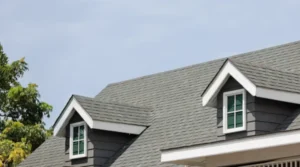The soaring roofs that grace the sun-kissed landscape of San Diego add undeniable charm to our homes. But beyond aesthetics, your roof plays a crucial role in protecting your living space from the elements. Understanding your roof’s pitch, and the angle of its slope, is key to choosing the right roofing materials, ensuring proper drainage, and maximizing attic space.
Even if you’re a San Diego homeowner with no experience in construction, figuring out your roof pitch is easier than you think! This beginner-friendly guide, brought to you by Peak Builders & Roofers of San Diego, your reliable roofing contractor, will equip you with the knowledge and tools to measure your roof pitch like a pro, without breaking a sweat.
Roof Pitch: A Beginner’s Guide to Easy Calculation Methods
Understanding the basics of roof pitch is crucial before diving into calculations. Roof pitch refers to the slope or incline of a roof. It is typically expressed as a ratio, such as 6:12, where the first number represents the vertical rise, and the second number indicates the horizontal run. Let’s explore some easy calculation methods suitable for beginners:
Ratio Method
Measure the vertical rise and horizontal run, and express them as a ratio.
Pitch Gauge Method
Utilize a pitch gauge tool to measure the slope directly.
The Basics: Understanding Roof Pitch and Its Importance in Construction
Understanding your roof pitch is crucial for several reasons:
- Material selection: Different roofing materials are suited for specific pitch ranges. Steeper pitches call for stronger materials like metal or slate, while flat roofs are ideal for lightweight shingles.
- Drainage optimization: A correct pitch ensures proper water runoff, preventing pooling and potential leaks. San Diego’s occasional rainstorms make proper drainage all the more important!
- Attic space utilization: Steeper pitches offer more headroom and potential for conversion into an extra living space.
- Building code compliance: Local building codes often have specific pitch requirements for roof types.
DIY Roof Pitch Measurement: Step-by-Step Guide for Novices
Method 1: The Triangle Trick
- Gather your tools: You’ll need a ladder, a rafter square (a special carpenter’s tool), a tape measure, and a pencil.
- Safely climb the ladder and reach a comfortable spot near the eaves. Make sure to follow safety precautions and work with a partner if needed.
- Extend the rafter square along the roofline: Place the long arm parallel to the roof’s slope and the short arm pointing straight down towards the base.
- Mark the point where the short arm meets the rafter square’s body. This measurement represents the “rise” of your roof.
- Measure the horizontal distance from the base of the eaves to the point you marked. This is the “run.”
- Divide the “rise” by the “run” and multiply by 12 to get your roof pitch in inches. For example, if your rise is 8 inches and run is 12 inches, your pitch is 8/12 x 12 = 8 inches, or a 2:3 pitch.
Method 2: The Level & Tape Measure Technique
- Locate a long, level wall adjacent to your house.
- Extend a tape measure vertically from the top of the wall to the roofline. Make sure it’s perpendicular to the wall.
- Measure the horizontal distance from the base of the wall to the point where the tape measure touches the roofline.
- Divide the vertical measurement by the horizontal measurement and multiply by 100 to get your roof pitch in degrees. For example, if your vertical measurement is 5 feet and your horizontal is 10 feet, your pitch is (5/10) x 100 = 50 degrees.
Common Pitfalls: Avoiding Mistakes in Roof Pitch Measurement
Even with user-friendly methods, common mistakes can occur. Learn to identify and avoid pitfalls to ensure accurate roof pitch calculations for your San Diego home.
- Inaccurate Measurements: Use precise tools and techniques to minimize measurement errors.
- Ignoring Roof Features: Account for dormers, valleys, and other features that can affect pitch measurements.
Tips from the Pros: Expert Advice for Easy Roof Pitch Determination
Benefit from the insights of roofing professionals with tips and tricks for easy roof pitch determination. These expert recommendations, coupled with flexible financing for your dream project can enhance your understanding and confidence in assessing roof pitch.
Consider Local Climate
Consider the region’s climate and rainfall patterns in San Diego when assessing roof pitch for optimal water drainage.
Regular Inspections
Schedule regular roof inspections to monitor any changes in pitch over time.
Conclusion: Mastering Roof Pitch without the Fuss
In conclusion, figuring out the roof pitch can be manageable, even for those with no prior experience. By understanding the basics, utilizing DIY methods, and incorporating technology, you can confidently assess your roof pitch.
Whether you’re in San Diego or elsewhere, mastering roof pitch empowers homeowners to make informed decisions and ensure the longevity and functionality of their roofs. For professional roofing services, kitchen remodeling, and bathroom remodeling in San Diego, trust Peak Builders & Roofers to make your home beautiful, one roof at a time.
Frequently Asked Questions (FAQs): Roof Pitch Calculation Made Easy
What is the standard roof pitch for homes in San Diego?
While it can vary, the standard roof pitch for homes in San Diego is often between 4:12 and 6:12, providing a good balance between aesthetics and functionality.
Can I measure the roof pitch without going on the roof?
Yes, using a pitch gauge or a telescoping pole from the ground can help you estimate roof pitch without climbing onto the roof.
Are there tools specifically designed for measuring roof pitch?
Yes, tools like pitch gauges and roofing calculators are designed for accurate roof pitch measurements and are readily available in San Diego.
How often should I check the pitch of my roof?
It’s advisable to check the pitch when conducting routine roof inspections or before any significant roofing projects.
Can I rely on visual recognition alone to determine roof pitch?
Visual recognition is a useful skill, but for precise measurements, using tools or apps is recommended, especially for accurate assessments in San Diego’s diverse neighborhoods.
Are there any local regulations in San Diego regarding roof pitch?
While there may not be specific regulations on roof pitch, complying with general building codes is essential. Check with local authorities for any specific requirements.



